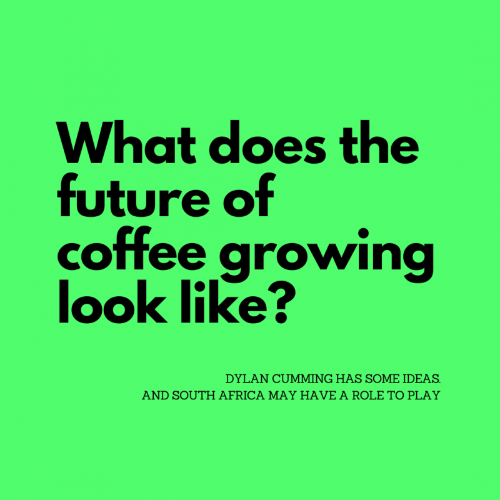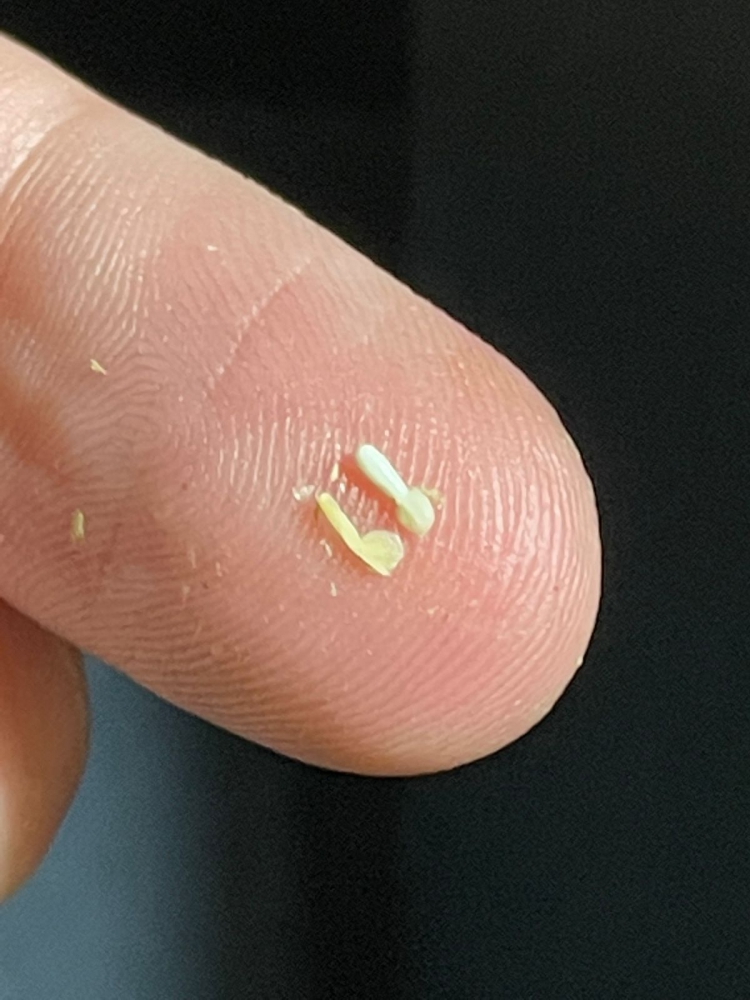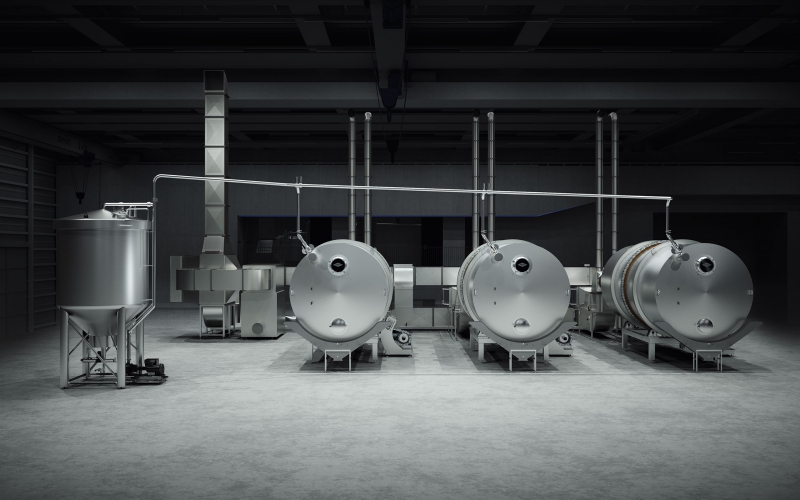
Words by Dylan Cumming
Dylan Cumming is breaking myths, misnomers, misconceptions and exploring the valorisation of coffee at origin through modernisation and the establishment of “new origins.” And South Africa could be at the centre of a new global movement.
Originally published in Issue 40, July 2022
The annual demand for coffee will reach 12 million tons by 2032. World coffee production will not match this relatively moderate growth demand curve. The reasons for this are due to a decade of low prices, land pressure, ageing farmers and climate change. Where will this supply come from?
There is a growing demand for specialty coffee worldwide from existing and emerging markets. I would argue that since containerisation in the 60’s, sophistication in optical sorting and the Grainpro bag, there has been no substantial increase in intrinsic quality of green coffee. You could also argue that these are only innovations of preservation and separation rather than the improvement of intrinsic quality.
South Africa has had two distinct eras of coffee production. 1870’s and a 100 years later in the 1970’s. The failure or failure to launch in both eras, in my estimation, was due to inadequate farmer knowledge, leaf rust, political issues, a fluctuating commodity price and the competition of cheap imports and a weak local demand.
There has over the last 10 years been a growing interest in coffee production in South Africa. This new era has also been fraught with issues with no substantial success stories. The issues South Africa faces and will face in the future are the same challenges that other producing countries are impacted by. Climate change, yield per hectare, traditional 100-year-old, outdated post-harvest processing and farmer profitability, being some of the most critical.
The world has been searching for solutions to these multiple problems that plague the coffee industry. These problems have become increasingly persistent over the past 10 years, leading to a largely unsustainable industry. I have begun to think of the nursery rhyme “There’s a hole in my bucket Dear Liza…” As the story tells, instead of trying to fix the hole, we need a “new bucket”. A re-engineering of the global value chain to create fair, equitable value to all stakeholders from grower to consumer.
Before we look at a new bucket, we first must debunk several myths, misnomers and misconceptions that are inhibiting the modernisation of the coffee industry.
In this article I’m going to outline them so that hopefully together we can begin to disrupt the traditional way we view the coffee value chain and break the current narrative of the coffee crisis, and ultimately presenting an alternative and sustainable future for coffee.
Misconception Altitude | Environment
The second most frequently asked question when I tell someone I am a coffee farmer is “What is your altitude or elevation?” This is usually the first question from industry professionals. It is used as a de facto measure of quality with the flawed thinking being the higher up the mountain the higher the quality.
Edward F. Fischer in his discussion paper Quality & Inequality (2017) 1 makes this point and its effect on the lower altitude grown coffee in a region in Guatemala. This misconception is continuously reinforced by labelling, advertisements, marketing material, green broker lists and geographical indicators like “Blue Mountain” or “Mount Kilimanjaro”.
So why has altitude become an indicator for value? Altitude is a proxy for temperature, in scientific fields, as Hanna Neushwander pointed out in her 2019 talk at Re:Co Symposium.
When we talk about altitude, what we are talking about is its climatic effect on temperature. But there are other geographical factors that affect temperature: Distance from a body of water, ocean currents, topography, aspect, rainfall, prevailing wind and one that has almost as much affect as altitude is latitude. In Wintgens book 2, Coffee: Growing, Processing, Sustainable Production this interplay is illustrated in a graph in it’s reference to coffee production around the globe.
We have recently completed a high-level suitability study of South Africa and have found over 750 000 ha of climate suitable land based on research of the agroclimatic zones of coffee Bunn (2015) 3. This study looked further into other lesser-known coffee producing countries and have found similar levels of suitability.
We consider climate important to the coffee plant health and yield potential and its quality, but why do we stop here? What about the effects of the climate or environment during post-harvest processing?
Coffee processing is traditional, 100 years old, but probably a better description is archaic or antiquated. Typically, where coffee is grown and harvested, it is where it is processed. The environmental conditions are having as much influence on coffee quality as its growing conditions.
Misnomer A Bean | Living Seed
Coffee is not a bean. This is a misnomer. Coffee is a seed.
During talks at Re:Co, Hanna Neuschwander from World Coffee Research describes the coffee seed as “a history book, a time capsule, a complex set of instructions…” and Flavio Borem spoke about “living tissue” on the importance of drying temperature and drying rate.
Coffee is an embryonic plant. That means the seed is made of three main structures: the seed coat, the endosperm and within that endosperm is a tiny living embryo. You probably have looked at the botanical picture of the coffee plant a million times, but most people miss it.

This is what the embryo looks like. If you’ve been on a coffee farm and looked at coffee drying, at a particular point that the endosperm is slightly translucent, there you will see that embryo.
The use of the word has begun to filtrate through the academic coffee industry. But its importance or relevance has not fully taken affect in practice.
Myth Coffee is like Wine | In fact, it's more like beer
The coffee industry is infatuated with the wine industry. We have learnt a lot from wine: geographic indicators in the promotion of coffee, the communication of terroir/origin and varieties on flavour and have also begun to price higher qualities coffee with the same elasticity.
About 10 years ago I watched the excitement around coffee “processing” grow. First with naturals and then more loudly with fermentation. There is a growing trend to sell coffee on the “fermentation” process and even borrowing from wine terminology like anaerobic fermentation and carbonic maceration.
At this point I had been working on processing for ten years and what they were saying didn’t seem right. In my years of coffee process experimentation of different wet methods did not result in changes that I was reading about or there didn’t seem like any consistency through the commentary.
I decided to work on it, little by little at first until three years ago when I began working on it full time. So the difficult task was to unthink those ideas from the text books, what I learnt from traditional processing folklore and began with the fundamentals. I went back to coffee is a seed.
If we go back to Biology 101, what is the sole responsibility of the seed? It’s to germinate. In this process the embryo is feeding off the endosperm. In that way the endosperm is being modified and changes in the chemical makeup, takes place. We always think of germination in its function, in the production of plants in a nursery. But this biological activity is taking place from the moment that the coffee cherry has been separated from the branch through all the processes of fermentation and drying.
Then I figured out a fundamental question. With coffee being a seed, does different levels or degrees of germination influence flavour?
It was at that this time that I began researching coffee germination and more broadly the biological activities of the coffee seed. It was then that I found a body of work by scientists that did a lot of research on how traditional post-harvest processing methods are influencing the biological activities of the coffee seed. Selmar (2000) 4.
So, in effect, we are roasting the endosperm of the fruit of the coffee tree that’s trying its best to kickstart it’s germination cycle. Yet there is little conversation about what is happening to the seed during post-harvest processing.
And then I figured out another more critical question: if we can control germination, can we control flavour?
I began to look at other industries beyond wine. I looked at other industries where germination is a key factor in influences flavour of the final product. If there is a parallel universe to the coffee industry, that has been missed, it’s the beer industry.
The ingredients to beer are simple: water, hops and barley. it’s the barley but more specifically what they do with it. Malting.
Barley is a grain, a seed. To influence its flavour, the malt master controls two things, germination and kilning. Kilning is akin to drying and roasting. These three processes combined will determine the style of beer that you are producing.
What can we transfer into coffee, can controlling germination result in consistent flavour? Are we leaving flavour pretty much to chance once the berry has been picked?

I believe that germination and the understanding of other biological activities and their control is the key to unlock coffees potential. The potential of flavour and value.
Changing the Value Chain | Upgrading or modernisation
Those that have been involved in the coffee industry long enough will have seen attempts to improve or move the value chain of coffee at various junctions. Rise of mainstream specialty coffee, certification and sustainable farming practices aiming to reduce producer risks and improve livelihoods. New purchasing models such as direct trade or relationship purchasing. New consumer experiences in specialty coffee. Improved science of roasting, new technology such as pod/capsule coffee. This is known as value chain upgrading.
Even with various and continual attempts at coffee value chain upgrading, the industry still finds itself in a vulnerable state that is not resilient to system shocks and many links in the chain seemly unable to move. Why with all this transformation activity in the chain the industry is facing some of the most challenging issues to date. Is there a piece of this puzzle that has not yet been incorporated into value chain upgrade perspective?
Surprisingly very little to no impactful upgrading has been directed towards the post-harvest processing. Possibly upgrading this component of the coffee value chain is the missing link to shifting the industry to one that is more sustainable, profitable and inclusive.
It could be argued that in the current coffee value ecosystem are not having the desired impact so perhaps it is time to fundamentally restructure how the ecosystem functions. Is it not time to renew this value ecosystem into the 4th industrial revolution?
It is time to modernise this ecosystem. Coffee 4.0
What does Modernisation mean? | Automation & Digitalisation
For centuries the way we process coffee has remained largely unchanged. Still using the same equipment and processes in typically an outdoor location, open to the environment and environmental conditions.
After looking at the beer and malting industries, I began to look at other industries that handle agricultural produce in a more controlled manner. I looked at the fruit industry, coffee is a fruit. I looked at fruit handling and selection technology, I looked at drying of fruit. I looked at new storage technology, both in management and environmental control.
What if we could harness current proven technology that has been upgrading other industries for decades. What if we had a new level of seedling production and quality, a new level of flavour control and development, a new competitive pricing model, new benefits stream at origin through radical farm gate pricing, with new holistic, inclusive and integrated producers of the future.
The rise of automation hugely increases productivity on production lines while digitalization streamlines processes and increases consistency, quality and transparency.
There are many benefits to this new approach, increased food safety, traceability, taste, lowering the price to consumers stimulating demand, shortens time to market improving cash flow improving origin economies, disrupting downstream focused coffee economics and evolving the coffee value ecosystem.
This system focuses on two key metrics: farm gate and consumer pricing, both with management will stimulate growth and a sustainable value ecosystem.
Currently there is little opportunity for the producer (especially the smallholder farmer) to earn a living wage. It is clear to those in the industry that this needs to be a change otherwise the sustainability of the industry is questionable. It is time that coffee is brought into the 4th industrial revolution and in line with the global sustainable development goals. What if we could centralise all these functions and technology under one roof…… at origin.
Super Factory | A New Bucket
We have been working over the past 5 years in reengineering the value chain to deliver a level of coffee quality and consistency never experienced before. By harnessing technology, we believe South Africa can become the world leader in coffee production and processing from field, harvest of cherry to finished product.
We are partnering with world class technology suppliers to design, build and implement a coffee super factory at origin with the highest quality and production capacity with the lowest possible operational costs. This new coffee at origin model is at scale and modular and aims to address key problems in the coffee sector and challenge the present norms in the coffee value chain. This is informed by our founding principles of farmer prosperity and price reduction for consumers.
This at origin factory model is supported by digital platform in development and will integrate all equipment and sensors for recipe development and automation. With our digitization will be able to create an infinite variety of coffee flavours, having full control of all the processes through all the phases of coffee from fruit (cherry) to green or roasted seed (bean) while tracing and tracking its journey from grower to consumer.
Introducing new technology from other developed industries and the state of art equipment from the coffee industry, our factory is a sustainable investment for green field projects or to increase value in an existing value chain. This solution presents a new opportunity for leading coffee industry stakeholders and investors.
With our partners, team of innovators, scientists, industry specialists and leading technology experts we believe the future of coffee sustainability will be dependent not on any current thinking in solving the cyclical “price crisis” but rather a total reengineering of the entire value chain.
Vuka phanda South Africa!
References